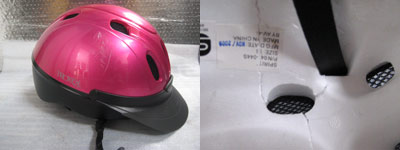Knowing when it’s time to replace a helmet is as critical to rider safety as wearing one. Even with limited use, a helmet’s hard foam lining can break down over time, says Drusilla Malavase, co-chair of the Equestrian Headgear Subcommittee for the American Society for Testing and Materials (ASTM).
To make the most of a helmet’s longevity, Malavase recommends storing it in an area where the temperature is moderate and consistent.
“I tell people to treat their helmets like a beloved dog or child,” she says. “Never store it in a hot car or in the tack room when it’s below zero [degrees Fahrenheit].”

Helmets should also be replaced when they are involved in a serious fall or other hard blow. Some warranties require that damaged helmets be returned to the manufacturer in order for owners to qualify for discounted replacement costs. At Troxel, those damaged and returned helmets are put to good use.
“At Troxel, our technical staff carefully examines select helmets that have been sent to us after accidents,” Says Jorge Garcia, VP of engineering at Troxel. “The outer shell often doesn’t show any damage, but after we disassemble the helmet, we find hairline cracks or compressed areas in the protective foam that absorbed the impact. All that means is that the helmet did its job by giving up its structural integrity to absorb some of the energy of the impact. Once the structure is compromised, the helmet would not perform the same way again if involved in a second accident. That is why we at Troxel urge riders to immediately replace a helmet that has been involved in any accident, even if the helmet does not appear to be damaged.”






I believe that a helmet replacement strategy is great. Horses are beautiful animals however they can be dangerous and scary. Especially when they do something that can fly you off of the horse. That is when a helmet is vital. Thanks again for sharing. http://www.onlineequinesupplies.com/